Top Rankings
Fairmont Area School District ranks among the top 20% of public school district in Minnesota for:
Category
Attribute
Community Size
Largest student body (number of students) (Top 1%)
For the 2025 school year, there are 2 public schools serving 1,818 students in Fairmont Area School District. This district's average testing ranking is 5/10, which is in the bottom 50% of public schools in Minnesota.
Public Schools in Fairmont Area School District have an average math proficiency score of 41% (versus the Minnesota public school average of 45%), and reading proficiency score of 49% (versus the 51% statewide average).
Minority enrollment is 28% of the student body (majority Hispanic), which is less than the Minnesota public school average of 39% (majority Black and Hispanic).
Overview
This School District
This State (MN)
# Schools
2 Schools
2,732 Schools
# Students
1,818 Students
870,790 Students
# Teachers
108 Teachers
57,779 Teachers
Student : Teacher Ratio
17:1
17:1
District Rank
Fairmont Area School District, which is ranked within the bottom 50% of all 522 school districts in Minnesota (based off of combined math and reading proficiency testing data) for the 2021-2022 school year.
The school district's graduation rate of 85-89% has decreased from 90-94% over five school years.
Overall District Rank
#259 out of 527 school districts
(Top 50%)
(Top 50%)
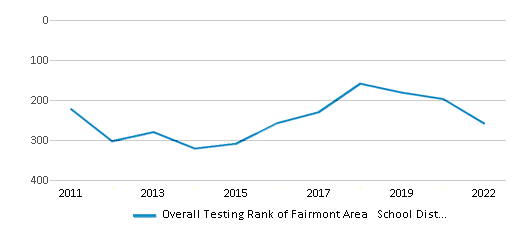
Math Test Scores (% Proficient)
41%
45%
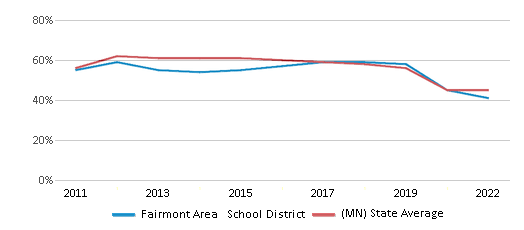
Reading/Language Arts Test Scores (% Proficient)
49%
51%
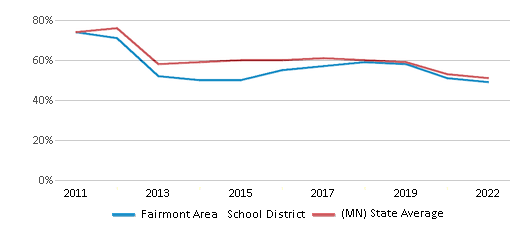
Science Test Scores (% Proficient)
33%
41%
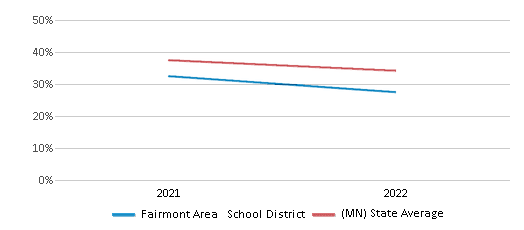
Graduation Rate
85-89%
84%

Students by Ethnicity:
Diversity Score
0.42
0.59
# American Indian Students
4 Students
15,699 Students
% American Indian Students
n/a
2%
# Asian Students
6 Students
61,819 Students
% Asian Students
n/a
7%
# Hispanic Students
423 Students
99,588 Students
% Hispanic Students
23%
12%
# Black Students
20 Students
102,736 Students
% Black Students
1%
12%
# White Students
1,317 Students
534,612 Students
% White Students
73%
61%
# Hawaiian Students
8 Students
1,007 Students
% Hawaiian Students
1%
n/a
# Two or more races Students
40 Students
55,329 Students
% of Two or more races Students
2%
6%
Students by Grade:
# Students in PK Grade:
103
24,648
# Students in K Grade:
110
59,654
# Students in 1st Grade:
120
61,859
# Students in 2nd Grade:
143
63,560
# Students in 3rd Grade:
128
61,751
# Students in 4th Grade:
135
63,575
# Students in 5th Grade:
113
63,290
# Students in 6th Grade:
122
63,180
# Students in 7th Grade:
121
63,243
# Students in 8th Grade:
136
64,723
# Students in 9th Grade:
135
67,716
# Students in 10th Grade:
175
69,634
# Students in 11th Grade:
135
69,942
# Students in 12th Grade:
142
74,015
# Ungraded Students:
-
-
District Revenue and Spending
The revenue/student of $15,199 in this school district is less than the state median of $17,854. The school district revenue/student has stayed relatively flat over four school years.
The school district's spending/student of $15,737 is less than the state median of $18,580. The school district spending/student has stayed relatively flat over four school years.
Total Revenue
$28 MM
$15,547 MM
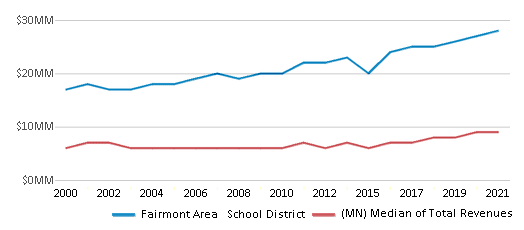
Spending
$29 MM
$16,179 MM
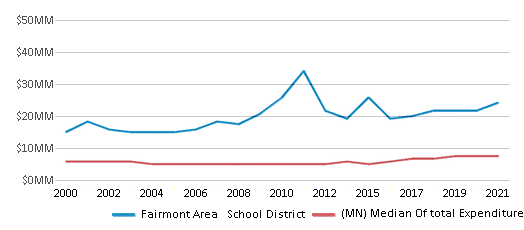
Revenue / Student
$15,199
$17,854
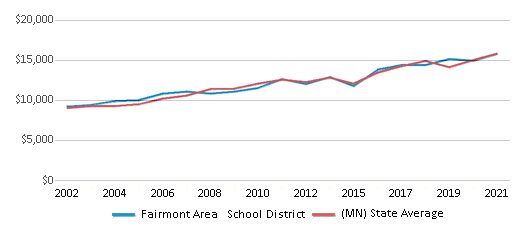
Spending / Student
$15,737
$18,580
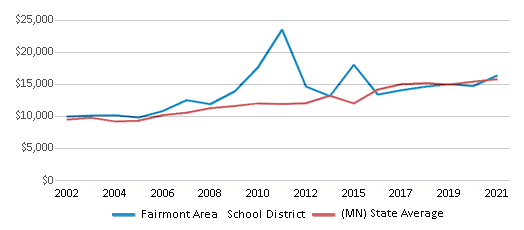
Best Fairmont Area School District Public Schools (2025)
School
(Math and Reading Proficiency)
(Math and Reading Proficiency)
Location
Grades
Students
Rank: #11.
Fairmont Elementary School
(Math: 48% | Reading: 52%)
Rank:
Rank:
6/
Top 50%10
714 Victoria Street Ste 101
Fairmont, MN 56031
(507) 238-4487
Fairmont, MN 56031
(507) 238-4487
Grades: PK-6
| 974 students
Rank: #22.
Fairmont Jr./sr. High School
(Math: 34% | Reading: 45%)
Rank:
Rank:
4/
Bottom 50%10
900 Johnson St
Fairmont, MN 56031
(507) 238-4411
Fairmont, MN 56031
(507) 238-4411
Grades: 7-12
| 844 students
Frequently Asked Questions
How many schools belong to Fairmont Area School District?
Fairmont Area School District manages 2 public schools serving 1,818 students.
What is the rank of Fairmont Area School District?
Fairmont Area School District is ranked #271 out of 522 school districts in Minnesota (bottom 50%) based off of combined math and reading proficiency testing data for the 2021-2022 school year. This district ranks in the top 20% of Minnesota school districts for: Largest student body (number of students) (Top 1%)
What is the racial composition of students in Fairmont Area School District?
73% of Fairmont Area School District students are White, 23% of students are Hispanic, 2% of students are Two or more races, 1% of students are Black, and 1% of students are Hawaiian.
What is the student/teacher ratio of Fairmont Area School District?
Fairmont Area School District has a student/teacher ratio of 17:1, which is higher than the Minnesota state average of 15:1.
What is Fairmont Area School District's spending/student ratio?
The school district's spending/student of $15,737 is less than the state median of $18,580. The school district spending/student has stayed relatively flat over four school years.
Recent Articles

Year-Round Or Traditional Schedule?
Which is more appropriate for your child? A year-round attendance schedule or traditional schedule? We look at the pros and cons.

Why You Should Encourage Your Child to Join a Sports Team
Participating in team sports has a great many benefits for children, there is no doubt. In this article you will learn what those benefits are.

White Students are Now the Minority in U.S. Public Schools
Increasing birth rates among immigrant families from Asia and Central and South America, combined with lower birth rates among white families, means that for the first time in history, public school students in the United States are majority-minority. This shift in demographics poses difficulties for schools as they work to accommodate children of varying language abilities and socio-economic backgrounds.





